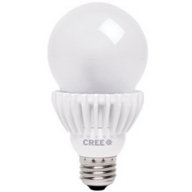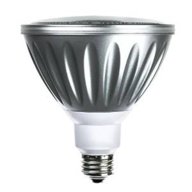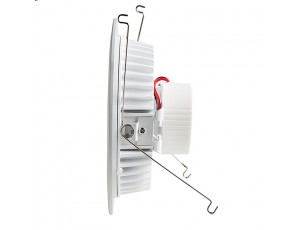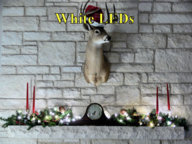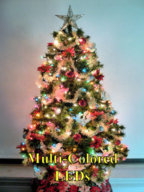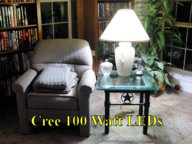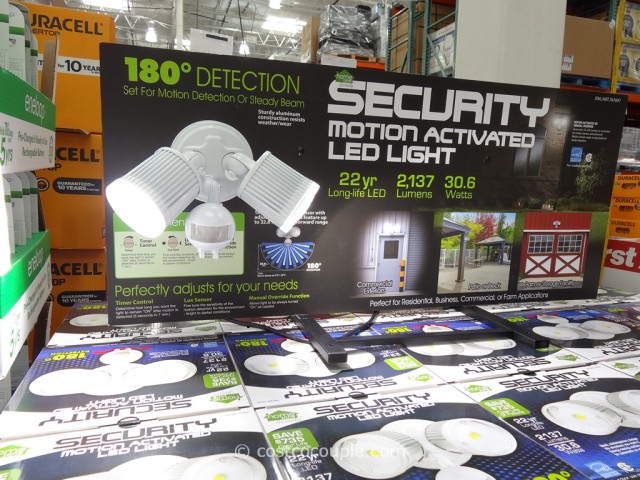Incandescent era, RIP. Like it or not, it's time to move on... thanks to congressional meddling.
So, what now??? According to a survey by switch manufacturer Lutron, 67% of American adults were unaware of the 'Energy Independence and Security Act' (EISA), passed in 2007 , but only 10% are 'very knowledgeable' about replacement options. Most will probably buy halogens without even noticing. At about $1 apiece they are cheap & they look, feel & function almost exactly like traditional incandescents. But they're only about 25% more efficient (just enough to meet EISA standards). Meanwhile, CFLs (which are inherently flawed & generally unpopular), are steadily losing market share.
That leaves LEDs, which offer the most sustainable, (& IMO exciting) alternative to incandescents. For starters, they're highly efficient... the average efficacy of an LED bulb is 78 lm/w (lumens per watt), compared with around 13 lm/w for an incandescent & approximately 18 lm/w for a halogen equivalent. Yes, LEDs have their shortcomings... Buying an LED bulb doesn't seem as intuitive as picking up an incandescent from your local drug store, & the up-front cost is relatively high. But once you get to know the technology & the incomparable versatility that LEDs offer, you'll view the demise of the incandescent as an opportunity, just as I have.
Aren't LEDs Expensive???
The days of the $30 LED bulb are over. As demand has increased & manufacturing processes have become more streamlined, costs have plummeted. Additionally, utility company rebates have driven the price of many household replacements to below $10; in some regions they cost half that. Sure, that's a long way from the 50-cent incandescent, but consider this: LED bulbs consume one-sixth the energy of incandescents & last up to 25 times longer. Replacing a 60-watt incandescent with an LED equivalent will save you $130 in energy costs over the new bulb's lifetime. The average American household could slash $150 from its annual energy bill by replacing all incandescents with LED bulbs.
What Am I Looking At On The Label???
Today all light bulb packaging carries the Federal Trade Commission's Lighting Facts label, which lets you compare similar bulbs without relying on watts as the sole indicator of performance. It gives information about the bulb's brightness (in lumens); yearly cost (based on 3 hours of daily use), life expectancy (in years), light appearance (aka color temperature) measured in Kelvins (K) & energy consumed (in watts). Just remember, an LED bulb's wattage rating doesn't indicate its brightness, its lumens rating does.
The higher the bulb's color temperature, the cooler its light. A candle glows at a color temperature of 1500 K. That CFL you tried but hated because its light was too harsh was probably running at around 4500 K. LED bulbs marketed as incandescent replacements usually have a color temperature of 2700 K, which is equivalent to typical warm white incandescents.
But that's only part of the story. The quality of a bulb's light also depends on its color accuracy, also known as the color rendering index (CRI). The higher the bulb's CRI, the more realistically it reveals colors.
Incandescent light bulbs have a CRI of 100, but most CFLs & LED bulbs have CRIs in the 80s. According to a recent study by the DOE, only a handful of LED bulbs have CRIs in the 90s, though that will improve as efficacy increases. Note that the CRI is not always listed on the packaging, so you may have to search the manufacturer's website for it.
Is there really any difference between a $5 LED & a $20 LED???
Heck yes. LEDs are very similar to consumer electronics & quality really matters. In order for an LED to function properly & provide an acceptable light output, all of the components must be built to last. It's always a good idea to buy from a manufacturer & retailer that you're confident will stand behind the product. If you'd like to learn more about the components and how cheaply-made LEDs stack up against top-quality product, check out A Tale of Two Bulbs.
These Bulbs Dim, Right???
Yes & No. No all are dimmable. LED bulbs sold as dimmable work acceptably with most newer switches. The best dim to about 5 percent, though at that level some produce a faint buzzing. Make sure you buy a bulb that has been verified to work properly with your switch; check the manufacturer's website for a list of compatible dimmers. If you need to install a new switch, buy something specifically engineered to work with LED bulbs.
What Exactly Is An LED???
The acronym stands for 'light emitting diode'... As indicated by its name, the LED is simply a diode that emits light. A diode is a device that allows current to flow in only one direction. Almost any two conductive materials will form a diode when placed in contact with each other. When electricity is passed through the diode the atoms in one material (within the semiconductor chip) are excited to a higher energy level. The atoms in that first material have too much energy & need to release that energy. The energy is then released as the atoms shed electrons to the other material within the chip. During this energy release light is created. The color of the light from the LED is a function of the materials & processes that make up the chip.
So, what now??? According to a survey by switch manufacturer Lutron, 67% of American adults were unaware of the 'Energy Independence and Security Act' (EISA), passed in 2007 , but only 10% are 'very knowledgeable' about replacement options. Most will probably buy halogens without even noticing. At about $1 apiece they are cheap & they look, feel & function almost exactly like traditional incandescents. But they're only about 25% more efficient (just enough to meet EISA standards). Meanwhile, CFLs (which are inherently flawed & generally unpopular), are steadily losing market share.
That leaves LEDs, which offer the most sustainable, (& IMO exciting) alternative to incandescents. For starters, they're highly efficient... the average efficacy of an LED bulb is 78 lm/w (lumens per watt), compared with around 13 lm/w for an incandescent & approximately 18 lm/w for a halogen equivalent. Yes, LEDs have their shortcomings... Buying an LED bulb doesn't seem as intuitive as picking up an incandescent from your local drug store, & the up-front cost is relatively high. But once you get to know the technology & the incomparable versatility that LEDs offer, you'll view the demise of the incandescent as an opportunity, just as I have.
Aren't LEDs Expensive???
The days of the $30 LED bulb are over. As demand has increased & manufacturing processes have become more streamlined, costs have plummeted. Additionally, utility company rebates have driven the price of many household replacements to below $10; in some regions they cost half that. Sure, that's a long way from the 50-cent incandescent, but consider this: LED bulbs consume one-sixth the energy of incandescents & last up to 25 times longer. Replacing a 60-watt incandescent with an LED equivalent will save you $130 in energy costs over the new bulb's lifetime. The average American household could slash $150 from its annual energy bill by replacing all incandescents with LED bulbs.
What Am I Looking At On The Label???
Today all light bulb packaging carries the Federal Trade Commission's Lighting Facts label, which lets you compare similar bulbs without relying on watts as the sole indicator of performance. It gives information about the bulb's brightness (in lumens); yearly cost (based on 3 hours of daily use), life expectancy (in years), light appearance (aka color temperature) measured in Kelvins (K) & energy consumed (in watts). Just remember, an LED bulb's wattage rating doesn't indicate its brightness, its lumens rating does.
The higher the bulb's color temperature, the cooler its light. A candle glows at a color temperature of 1500 K. That CFL you tried but hated because its light was too harsh was probably running at around 4500 K. LED bulbs marketed as incandescent replacements usually have a color temperature of 2700 K, which is equivalent to typical warm white incandescents.
But that's only part of the story. The quality of a bulb's light also depends on its color accuracy, also known as the color rendering index (CRI). The higher the bulb's CRI, the more realistically it reveals colors.
Incandescent light bulbs have a CRI of 100, but most CFLs & LED bulbs have CRIs in the 80s. According to a recent study by the DOE, only a handful of LED bulbs have CRIs in the 90s, though that will improve as efficacy increases. Note that the CRI is not always listed on the packaging, so you may have to search the manufacturer's website for it.
Is there really any difference between a $5 LED & a $20 LED???
Heck yes. LEDs are very similar to consumer electronics & quality really matters. In order for an LED to function properly & provide an acceptable light output, all of the components must be built to last. It's always a good idea to buy from a manufacturer & retailer that you're confident will stand behind the product. If you'd like to learn more about the components and how cheaply-made LEDs stack up against top-quality product, check out A Tale of Two Bulbs.
These Bulbs Dim, Right???
Yes & No. No all are dimmable. LED bulbs sold as dimmable work acceptably with most newer switches. The best dim to about 5 percent, though at that level some produce a faint buzzing. Make sure you buy a bulb that has been verified to work properly with your switch; check the manufacturer's website for a list of compatible dimmers. If you need to install a new switch, buy something specifically engineered to work with LED bulbs.
What Exactly Is An LED???
The acronym stands for 'light emitting diode'... As indicated by its name, the LED is simply a diode that emits light. A diode is a device that allows current to flow in only one direction. Almost any two conductive materials will form a diode when placed in contact with each other. When electricity is passed through the diode the atoms in one material (within the semiconductor chip) are excited to a higher energy level. The atoms in that first material have too much energy & need to release that energy. The energy is then released as the atoms shed electrons to the other material within the chip. During this energy release light is created. The color of the light from the LED is a function of the materials & processes that make up the chip.


